Global Discoveries on DVD: Mostly Items from Overseas
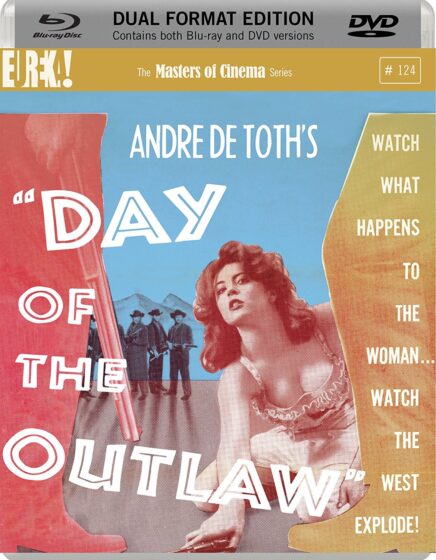
By Jonathan Rosenbaum
1. A package of wonderful releases arrived from Eureka’s Masters of Cinema series in the UK, all of them with exceptional extras. Here are the most exciting of these packages, in alphabetical order:
Andre De Toth’s Day of the Outlaw (1959), in dual formats—a masterpiece of disequilibrium and the starkest of black-and-white widescreen Westerns. Bertrand Tavernier’s passionate reflections on the film, delivered to camera, include his reasons for calling the film Dreyeresque (an adjective I’ve applied elsewhere to William A. Wellman’s 1954 Track of the Cat, which was shot in colour and CinemaScope but designed in black and white). I can see what he means, but I’d like to offer as a counter-proposal the fact that Day of the Outlaw could be described as a very Hungarian Western: in its bleak miserabilism, edgy confrontations, and desolate landscapes and barren interiors, it invites comparison with such existentialist Béla Tarr masterpieces as Damnation (desperate adultery and mud), Sátántangó (demonic dancing, abject treks, Burl Ives’ fallen patriarch, and Peter Berling’s drunken doctor), and The Turin Horse (apocalyptic futility). Other extras include Glenn Kenny’s excellent analysis of De Toth’s mise en scène, a 1995 De Toth interview, and the film’s original press book.
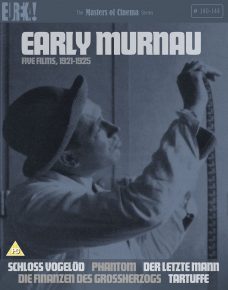 Early Murnau (1921-1925), Blu-ray box set. An essential package encompassing Castle Vogelöd (1921), Phantom (1922), The Grand Duke’s Finances (1924), The Last Laugh (1924), Tartuffe (1925), and a 100-page booklet including texts by Charles Jameux, Lotte H. Eisner, Janet Bergstrom, R. Dixon Smith, Tony Rayns, Robert Herlth, and Murnau. One curious anomaly in the packaging: inside the box are two plastic cases, the first including one Blu-ray with Castle Vogelöd and Phantom (but featuring posters for Castle Vogelöd and Tartuffe on its cover and listing all the titles except for The Last Laugh on the spine), the second including two Blu-rays, one with The Last Laugh, the other with The Grand Duke’s Finances and Tartuffe (but acknowledging only The Last Laugh on the cover and spine). These are quibbles, but they do interfere a tad with the set’s user-friendliness.
Early Murnau (1921-1925), Blu-ray box set. An essential package encompassing Castle Vogelöd (1921), Phantom (1922), The Grand Duke’s Finances (1924), The Last Laugh (1924), Tartuffe (1925), and a 100-page booklet including texts by Charles Jameux, Lotte H. Eisner, Janet Bergstrom, R. Dixon Smith, Tony Rayns, Robert Herlth, and Murnau. One curious anomaly in the packaging: inside the box are two plastic cases, the first including one Blu-ray with Castle Vogelöd and Phantom (but featuring posters for Castle Vogelöd and Tartuffe on its cover and listing all the titles except for The Last Laugh on the spine), the second including two Blu-rays, one with The Last Laugh, the other with The Grand Duke’s Finances and Tartuffe (but acknowledging only The Last Laugh on the cover and spine). These are quibbles, but they do interfere a tad with the set’s user-friendliness.
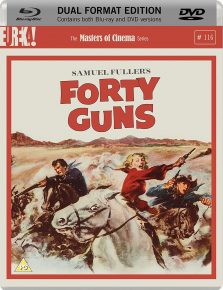 Samuel Fuller’s Forty Guns (1957) in dual formats. This also has an on-camera French commentator, Jean-Louis Leutrat, who does a pretty good job, although it would have been less confusing if his allusions to “double projection” had been subtitled “double feature” rather than “dual screening.” But the real gems in this package are an audio recording of Fuller speaking at the National Film Theatre in 1969, not long after the Edinburgh Film Festival retrospective that sparked his critical discovery in the UK (including detailed accounts of his original ending for Forty Guns and some of the sequences in Shark! [1969] that got massacred by the producer), and a brilliant new essay by my favourite young French critic, Murielle Joudet (whose essay on Bette Davis can be accessed in English translation at www.lolajournal.com/6/davis.html, and whose cheering thoughts in French about James L. Brooks can be found in Trafic no. 97)—not to mention Jean-Luc Godard’s exuberant original review of Forty Guns and some relevant extracts from Fuller’s posthumously published memoir A Third Face. Fuller’s NFT rambles, I should add, are accompanied by all but the closing moments of Forty Guns, run without sound, and the sound then resumes for the film’s ending.
Samuel Fuller’s Forty Guns (1957) in dual formats. This also has an on-camera French commentator, Jean-Louis Leutrat, who does a pretty good job, although it would have been less confusing if his allusions to “double projection” had been subtitled “double feature” rather than “dual screening.” But the real gems in this package are an audio recording of Fuller speaking at the National Film Theatre in 1969, not long after the Edinburgh Film Festival retrospective that sparked his critical discovery in the UK (including detailed accounts of his original ending for Forty Guns and some of the sequences in Shark! [1969] that got massacred by the producer), and a brilliant new essay by my favourite young French critic, Murielle Joudet (whose essay on Bette Davis can be accessed in English translation at www.lolajournal.com/6/davis.html, and whose cheering thoughts in French about James L. Brooks can be found in Trafic no. 97)—not to mention Jean-Luc Godard’s exuberant original review of Forty Guns and some relevant extracts from Fuller’s posthumously published memoir A Third Face. Fuller’s NFT rambles, I should add, are accompanied by all but the closing moments of Forty Guns, run without sound, and the sound then resumes for the film’s ending.
 Kurosawa Kiyoshi’s Journey to the Shore (2015), in dual formats. I’ve been looking forward to this winner of Un Certain Regard’s director prize at Cannes last year ever since Raymond Bellour spoke rapturously to me about it in Paris last summer, and I wasn’t disappointed. But I’m stumped when it comes to describing the film except to call it, tentatively, a realistic Japanese ghost story—that is to say, a lyrical and serious film about how to negotiate past regrets and deceased partners. I’m not even confident that I fully understand it, but it’s an excellent example of a film whose unsolved puzzles remain seductive and, yes, haunting, in the best ghost-story sense. And it certainly does gorgeous things with light in the pursuit of these mysteries. I suspect that part of what makes it bemusing is its persuasive and psychologically plausible premise that dead people are sometimes still alive and sometimes not alive at all. The only extras here, apart from the trailer, are an essay by Anton Bitel and a statement by Kurosawa himself.
Kurosawa Kiyoshi’s Journey to the Shore (2015), in dual formats. I’ve been looking forward to this winner of Un Certain Regard’s director prize at Cannes last year ever since Raymond Bellour spoke rapturously to me about it in Paris last summer, and I wasn’t disappointed. But I’m stumped when it comes to describing the film except to call it, tentatively, a realistic Japanese ghost story—that is to say, a lyrical and serious film about how to negotiate past regrets and deceased partners. I’m not even confident that I fully understand it, but it’s an excellent example of a film whose unsolved puzzles remain seductive and, yes, haunting, in the best ghost-story sense. And it certainly does gorgeous things with light in the pursuit of these mysteries. I suspect that part of what makes it bemusing is its persuasive and psychologically plausible premise that dead people are sometimes still alive and sometimes not alive at all. The only extras here, apart from the trailer, are an essay by Anton Bitel and a statement by Kurosawa himself.
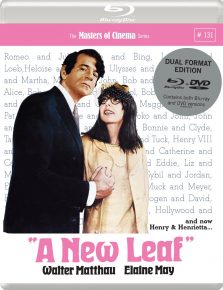 Elaine May’s A New Leaf (1971), in dual formats. The extras to May’s first feature are an audiovisual essay by David Cairns and a print essay by Glenn Kenny. Given the difficulties inherent in researching any May project due to her reluctance to grant interviews, I can easily forgive both Cairns and Kenny for omitting a few particulars about this comedy’s troubled production and post-production, but it may be useful to clarify a couple of points here by reproducing a footnote from an online article of mine based on a two-hour conversation that I had with May in Bologna in 2010: “May mentioned that her first choice for the male lead was actually Christopher Plummer (whose agent turned the part down before Plummer heard about it), and that she wound up playing the female lead largely because she wanted to avoid the studio’s own casting suggestions (which included Carol Channing). She described the murder of Weston as the funniest thing she ever saw [Walter] Matthau do (and told me she doesn’t know if the footage of this scene still exists), and added that this scene was cut because the Production Code wouldn’t allow his character to get away with murder.” I regret not thinking to ask May at the time whether she ever thought about publishing her original script for A New Leaf, which would at least bring some clarification about much of the material cut by Paramount.
Elaine May’s A New Leaf (1971), in dual formats. The extras to May’s first feature are an audiovisual essay by David Cairns and a print essay by Glenn Kenny. Given the difficulties inherent in researching any May project due to her reluctance to grant interviews, I can easily forgive both Cairns and Kenny for omitting a few particulars about this comedy’s troubled production and post-production, but it may be useful to clarify a couple of points here by reproducing a footnote from an online article of mine based on a two-hour conversation that I had with May in Bologna in 2010: “May mentioned that her first choice for the male lead was actually Christopher Plummer (whose agent turned the part down before Plummer heard about it), and that she wound up playing the female lead largely because she wanted to avoid the studio’s own casting suggestions (which included Carol Channing). She described the murder of Weston as the funniest thing she ever saw [Walter] Matthau do (and told me she doesn’t know if the footage of this scene still exists), and added that this scene was cut because the Production Code wouldn’t allow his character to get away with murder.” I regret not thinking to ask May at the time whether she ever thought about publishing her original script for A New Leaf, which would at least bring some clarification about much of the material cut by Paramount.
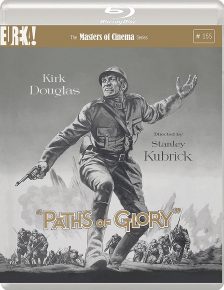 Stanley Kubrick’s Paths of Glory (1957), on Blu-ray. Lots of extras here, including the film’s original theatrical trailer, a fine audio commentary by Adrian Martin, an especially cogent onscreen interview with Richard Combs (my former boss at Monthly Film Bulletin in the mid-’70s) that has much to suggest about Kubrick’s work as a whole, other video interviews with Peter Kramer and Richard Ayoade, a reprint of a 1959 article by Colin Young including some interview material with Kubrick, and a new essay by Glenn Kenny. And the film, needless to say, looks great.
Stanley Kubrick’s Paths of Glory (1957), on Blu-ray. Lots of extras here, including the film’s original theatrical trailer, a fine audio commentary by Adrian Martin, an especially cogent onscreen interview with Richard Combs (my former boss at Monthly Film Bulletin in the mid-’70s) that has much to suggest about Kubrick’s work as a whole, other video interviews with Peter Kramer and Richard Ayoade, a reprint of a 1959 article by Colin Young including some interview material with Kubrick, and a new essay by Glenn Kenny. And the film, needless to say, looks great.
2. Numéro Trois: Variations sur Numéro Deux de Jean-Luc Godard is an interesting bilingual book (176 pages) + DVD (86 minutes) combo that I purchased for 20 Euros on French Amazon, and that turns out to be less specialized than its title may suggest. The texts in the book are by Pascal Beausse, Nicole Brenez, Antoine Dufeu, Harun Farocki and Kaja Silverman, Eloy Fernández Porta, and Carlos Losilla. The DVD contains a fascinating experimental essay film by Jordi Vidal in collaboration with Andreïna Mastio called History Minus Zero_No Limit, whose relation to Godard’s Numéro Deux is both formal (double screens, printed titles) and thematic (political, philosophical, and metaphysical) without being imitative in any significant way.
 3. Three elegant trilingual (English, French, Portuguese) DVD releases from the team of FNAC and Curtas Vila do Conde (the latter an ambitious Portuguese film festival devoted to shorts), each one available for the ridiculously low price of four Euros from Portuguese FNAC (FNAC.pt): Reconversão (Reconversion), Thom Andersen’s striking 2012 documentary about architect Eduardo Souto de Moura; a collection of half a dozen short films by Miguel Gomes; and a collection of nine short films by João Pedro Rodrigues and João Rui Guerra da Mata. The first of these releases includes two extras: a breathtakingly beautiful and highly original documentary by Peter Bo Rappmund, Reconversão’s Dallas-based cinematographer, called Vulgar Fractions (2011), described on Rappmund’s website as “seven unique state intersections along Nebraska’s border”; and Rappmund’s own selection of “20 Photos from the Film Reconversão,” which is roughly akin to a slide show. (Meanwhile, Cinema Guild has just released on DVD the recent UCLA restoration of Andersen’s first major film essay, the superb, hour-long Eadweard Muybridge, Zoopraxographer [1975], along with a couple of printed essays about it by Andersen and Ross Lipman.)
3. Three elegant trilingual (English, French, Portuguese) DVD releases from the team of FNAC and Curtas Vila do Conde (the latter an ambitious Portuguese film festival devoted to shorts), each one available for the ridiculously low price of four Euros from Portuguese FNAC (FNAC.pt): Reconversão (Reconversion), Thom Andersen’s striking 2012 documentary about architect Eduardo Souto de Moura; a collection of half a dozen short films by Miguel Gomes; and a collection of nine short films by João Pedro Rodrigues and João Rui Guerra da Mata. The first of these releases includes two extras: a breathtakingly beautiful and highly original documentary by Peter Bo Rappmund, Reconversão’s Dallas-based cinematographer, called Vulgar Fractions (2011), described on Rappmund’s website as “seven unique state intersections along Nebraska’s border”; and Rappmund’s own selection of “20 Photos from the Film Reconversão,” which is roughly akin to a slide show. (Meanwhile, Cinema Guild has just released on DVD the recent UCLA restoration of Andersen’s first major film essay, the superb, hour-long Eadweard Muybridge, Zoopraxographer [1975], along with a couple of printed essays about it by Andersen and Ross Lipman.)
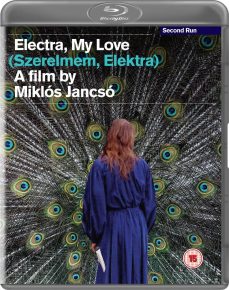 4. A breathtaking discovery: Miklós Jancsó’s 1974 Electra, My Love, the first (and, one hopes, not the last) of his films to surface on Blu-ray, thanks to Second Run Features in the UK (which has also brought us a Blu-ray of Pedro Costa’s Horse Money, as I noted two columns back). Electra is an exuberant (if tragic) musical that I’m tempted to redub Blue Psalm, inasmuch as it reprises many of the procedures of Jancsó’s Red Psalm (1971), with a somewhat different colour scheme and an even more reduced number of choreographic extended long takes, with only a dozen shots this time versus Red Psalm’s 28. Based on a verse play by Laszlo Gyurko—the same Hungarian writer who wrote the source novel for Jancsó’s 450-minute TV miniseries Faustus Faustus Faustus (1984)—this balletic approach to the Greek myth appears to be the climax of what Peter Hames (in his helpful accompanying essay) describes as Jancsó’s cycle of “revolutionary street pageants” in which “the individual is presented in relation to a group, a class, a state—a social context of power and repression that is always present.”
4. A breathtaking discovery: Miklós Jancsó’s 1974 Electra, My Love, the first (and, one hopes, not the last) of his films to surface on Blu-ray, thanks to Second Run Features in the UK (which has also brought us a Blu-ray of Pedro Costa’s Horse Money, as I noted two columns back). Electra is an exuberant (if tragic) musical that I’m tempted to redub Blue Psalm, inasmuch as it reprises many of the procedures of Jancsó’s Red Psalm (1971), with a somewhat different colour scheme and an even more reduced number of choreographic extended long takes, with only a dozen shots this time versus Red Psalm’s 28. Based on a verse play by Laszlo Gyurko—the same Hungarian writer who wrote the source novel for Jancsó’s 450-minute TV miniseries Faustus Faustus Faustus (1984)—this balletic approach to the Greek myth appears to be the climax of what Peter Hames (in his helpful accompanying essay) describes as Jancsó’s cycle of “revolutionary street pageants” in which “the individual is presented in relation to a group, a class, a state—a social context of power and repression that is always present.”
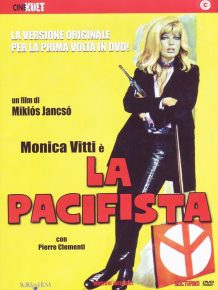 5. This cycle apparently begins with The Confrontation (1968), followed by Red Psalm, and it’s worth noting that both are available on DVD from Second Run, along with a separate Miklós Jancsó Collection including My Way Home (1964), The Round-up (1965), and The Red and the White (1967). But if you’re eager to see still more from this prolific Hungarian master and you can read French subtitles, I can recommend the massive DVD package from Clavis Films in France, also called Miklós Jancsó Collection, cited in my last column as a personal favourite by Paolo Mereghetti in Il Cinema Ritrovato’s DVD Awards. This includes Cantata (1963, his second feature), My Way Home, The Round-up (called Les sans-espoirs in French), The Red and the White, Silence and Cry (1968), Sirocco d’Hiver (1969), Red Psalm, Electra, My Love, The Tyrant’s Heart (1981), and Season of Monsters (1987), along with half a dozen shorts, diverse documentary extras, and a 50-page booklet. And whether or not you speak or read Italian (I can only do the latter partially, imperfectly, and fitfully), if you want to see what it was like when Jancsó directed Monica Vitti and Pierre Clementi, you can order La pacifista (1970) fairly cheaply from Italian Amazon, as I did. Also, I hold out some hopes for Faustus Faustus Faustus eventually becoming available with English subtitles because I saw the impressive first episode that way in Rotterdam 30-odd years ago, and recall that at the time Ian Christie was speaking about Channel 4 in the UK broadcasting the whole thing.
5. This cycle apparently begins with The Confrontation (1968), followed by Red Psalm, and it’s worth noting that both are available on DVD from Second Run, along with a separate Miklós Jancsó Collection including My Way Home (1964), The Round-up (1965), and The Red and the White (1967). But if you’re eager to see still more from this prolific Hungarian master and you can read French subtitles, I can recommend the massive DVD package from Clavis Films in France, also called Miklós Jancsó Collection, cited in my last column as a personal favourite by Paolo Mereghetti in Il Cinema Ritrovato’s DVD Awards. This includes Cantata (1963, his second feature), My Way Home, The Round-up (called Les sans-espoirs in French), The Red and the White, Silence and Cry (1968), Sirocco d’Hiver (1969), Red Psalm, Electra, My Love, The Tyrant’s Heart (1981), and Season of Monsters (1987), along with half a dozen shorts, diverse documentary extras, and a 50-page booklet. And whether or not you speak or read Italian (I can only do the latter partially, imperfectly, and fitfully), if you want to see what it was like when Jancsó directed Monica Vitti and Pierre Clementi, you can order La pacifista (1970) fairly cheaply from Italian Amazon, as I did. Also, I hold out some hopes for Faustus Faustus Faustus eventually becoming available with English subtitles because I saw the impressive first episode that way in Rotterdam 30-odd years ago, and recall that at the time Ian Christie was speaking about Channel 4 in the UK broadcasting the whole thing.
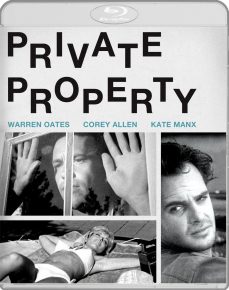 6. I never quite got around to seeing writer-director Leslie Stevens’ arty Los Angeles indie Private Property when it opened in New York in 1960, mainly because the negative accounts of it from Dwight Macdonald and others persuaded me that it wasn’t my cup of tea. It still isn’t, although now that UCLA has restored it after over half a century of neglect, and Cinelicious Pics has brought it out in a nice dual-format package—with a video interview with technical consultant and stills photographer Alexander Singer (also a former Kubrick cohort) and an informative essay by Don Malcolm—I’m glad that I’ve belatedly caught up with it. Two of its major points of interest: it features the first major screen performance of Warren Oates, playing the dimwitted, virginal sidekick of a sleazy con artist (well-played by Corey Allen, James Dean’s romantic rival and chickie-run antagonist in Rebel Without a Cause) who contrives to seduce a wealthy married bimbo (the late Kate Manx, Stevens’ wife at the time); and its striking and fancy cinematography is by Ted McCord and Conrad Hall.
6. I never quite got around to seeing writer-director Leslie Stevens’ arty Los Angeles indie Private Property when it opened in New York in 1960, mainly because the negative accounts of it from Dwight Macdonald and others persuaded me that it wasn’t my cup of tea. It still isn’t, although now that UCLA has restored it after over half a century of neglect, and Cinelicious Pics has brought it out in a nice dual-format package—with a video interview with technical consultant and stills photographer Alexander Singer (also a former Kubrick cohort) and an informative essay by Don Malcolm—I’m glad that I’ve belatedly caught up with it. Two of its major points of interest: it features the first major screen performance of Warren Oates, playing the dimwitted, virginal sidekick of a sleazy con artist (well-played by Corey Allen, James Dean’s romantic rival and chickie-run antagonist in Rebel Without a Cause) who contrives to seduce a wealthy married bimbo (the late Kate Manx, Stevens’ wife at the time); and its striking and fancy cinematography is by Ted McCord and Conrad Hall.
The film belongs to the same sadistic sub-genre as Cape Fear (both the 1962 and 1991 versions), Sam Peckinpah’s Straw Dogs (1971), Elia Kazan’s neglected (and toxic) The Visitors (1972), and Michael Haneke’s Funny Games (both the 1997 and 2007 versions), in which we’re essentially asked to sit around waiting for a climactic rape and/or other forms of violent coercion and abuse. I don’t like any of these movies (discounting the Funny Games remake, which I studiously avoided), and I can’t say that Private Property is made any better by borrowing its two male leads from John Steinbeck’s Of Mice and Men while anticipating and perhaps even influencing some or all the other items in its sub-genre. Stevens remains a difficult-to-classify oddball who shot this first feature in his own home and in and around his own swimming pool over the Sunset Strip; he subsequently created the TV series The Outer Limits (1963-65) and directed a horror film with dialogue in Esperanto (Incubus, 1966). If pressed, I suppose I would classify him as one of those “Subjects for Further Research,” as per Andrew Sarris’ category in The American Cinema—though Sarris himself dismisses Stevens rather summarily in the same volume under “Miscellany.”
Jonathan Rosenbaum- « Previous
- 1
- 2


